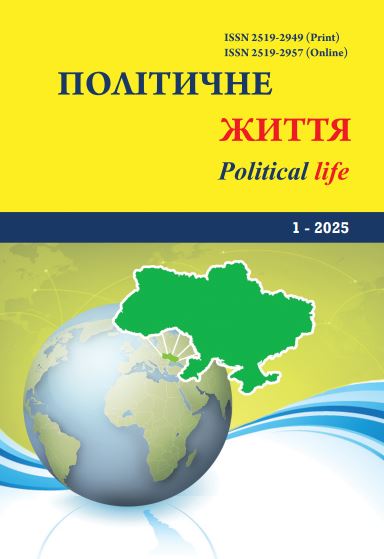Fragility is required: peacebuilding theory brief overview
DOI:
https://doi.org/10.31558/2519-2949.2025.1.12Keywords:
conflict resolution, peacebuilding, peace and conflict studies, liberal peace, a top-down approach to peacebuilding, a bottom-up approach to peacebuilding, hybrid peace, fragile statesAbstract
A state or territory emerging from an armed conflict undergoes a process of constructing a new reality. The peacebuilding process involves a broad range of measures focused not only on rebuilding territories affected by armed conflict but, more importantly, on identifying and strengthening institutions dedicated to fostering peace and preventing the recurrence of conflict. This article attempts to outline the main theoretical approaches and perspectives in peacebuilding research and its implementation. This study examines the perception of peacebuilding through conflict resolution as a key multidisciplinary approach. The conceptual analysis highlighted distinctive features of peacebuilding compared to related interconnected terms, such as conflict prevention, peacekeeping, peacemaking, postwar reconstruction, statebuilding, nation building, and reconciliation. A structural-functional analysis made it possible to differentiate theoretical approaches to peacebuilding activities involvement. The differences between peacebuilding from above (top-down approach) and peacebuilding from below (bottom-up approach) are analyzed. The essence of the hierarchical approach through the liberal paradigm is revealed in contrast to the idea of a hybrid peace. An exceptional impact of the transformative approach on peacebuilding is highlighted. The current trend of cosmopolitan conflict resolution is described. Emphasis is placed on the prevailing perception of peacebuilding as a viable endeavor during the fragile phase of post-conflict interaction and the state of conflict actors, particularly concerning the capacity for flexibility and adaptability to evolving circumstances and changes. This article does not strive to comprehensively present all existing theoretical frameworks to peacebuilding. Instead, it aims to delineate its distinctive attributes and to serve as a catalyst for further scholarly inquiry in this domain.
References
The past and future(s) of environmental peacebuilding (2021). T. Ide et al. International Affairs. Vol. 97(1). P. 1-16.
Civil society, peacebuilding from below and shrinking civic space: the case of Cameroon’s «Anglophone» conflict (2021). N. Annan N. et al. Conflict, Security & Development. No.21(6). P. 697-725.
Paffenholz T. (2021). Perpetual Peacebuilding: A New Paradigm to Move Beyond the Linearity of Liberal Peacebuilding. Journal of Intervention and Statebuilding. No.15(3). P. 367-385.
Simangan D. (2024). Challenges and Prospects for Urban Peacebuilding in Post-Siege Marawi City, Philippines: People, Places, and Practices. Journal of Current Southeast Asian Affairs. Vol.43(3). DOI: 10.1177/18681034241251864.
Ramsbotham O., Woodhouse T., Miall H. (2016). Contemporary Conflict Resolution. 4th edition (fully revised and updated). Cambridge: Polity Press. 604 p.
Galtung J. (1976). Three Approaches to Peace: Peacekeeping, Peacemaking, and Peacebuilding. Peace, War and Defense: Essays in Peace Research. Copenhagen: Christian Ejlers. P. 282-302.
Galtung J. (1990). Cultural violence. Journal of Peace Research. No.27(3). P. 291-305.
Richmond O.P. (2006). The problem of peace: understanding the «liberal peace». Conflict, Security & Development. No.3. P. 291-314.
Lederach J.P. (1997). Building Peace: Sustainable Reconciliation in Divided Societies. Washington, DC: US Institute of Peace Press. 197 p.
States Emerging from Hybrid Political Orders – Pacific Experiences / V. Boege et al. The Australian Centre for Peace and Conflict Studies (ACPACS) Occasional Papers Series. September 2008. 41 p. URL: https://surl.li/tsxgyd.
Richmond O.P. (2011). A Post-Liberal Peace. London: Routledge. 288 p.
Galtung J. (1969). Violence, Peace and Peace Research. Journal of Peace Research. P. 167-191.
Azar E. (1991). The Analysis and Management of Protracted Social Conflict. The Psychodynamics of International Relationships. Vol.2. Lexington, MA: D.C. Health. P. 93-120. URL: https://www.bbau.ac.in/dept/dps/TM/Edward%20Azar.pdf.
Lederach J.P., Appleby S. (2010). Strategic Peacebuilding: An Overview. Strategies of Peace: Transforming Conflict in a Violent World / Ed. by D. Philpott and G. F. Powers. New York: Oxford University Press. P. 19-44.
What is Fragility? OECD. URL: https://www.oecd.org/en/blogs/2022/09/what-is-fragility.html.
The States of Fragility. OECD. URL: https://surl.li/nucgym.
Fragile States 2013: Resource Flows and Trends in a Shifting World. DAC (Development Assistance Committee). Paris: OECD, 2014. 105 p. URL: https://surl.li/skxeza.
Fragile States Index Annual Report 2023. The Fund for Peace. URL: https://fragilestatesindex.org/wp-content/uploads/2023/06/FSI-2023-Report_final.pdf.

